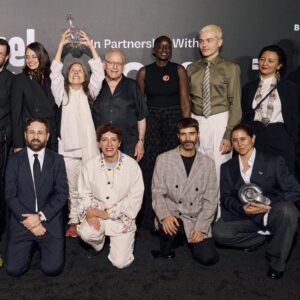
I’ve written four books about Nordic culture, but even as a Dane myself, the ever-evolving tenets of Scandinavian design never fail to amaze me. We Scandinavians are famous for our minimalism and utilitarianism—whether through elevated furniture design or democratic bike-happy fashion—but the source of our sublime aesthetic, I believe, lies in our social systems. The security afforded by the Danish welfare state paves the way for an emphasis on quality, venerating slow living instead of rapid construction and financial gain.
When I wrote my first book, Fashion Scandinavia, in 2013, the fashion scene in Copenhagen had nowhere near the amount of global interest it has today—if it had any at all. In the decade since, the rise in notoriety (due in part to social media) seems nearly exponential. Copenhagen has become an incubator for street style trends that, are inevitably reflected among the crowds at other international fashion weeks later on.

One of the highlights of this year’s calendar was Alectra Rothschild—a Central Saint Martin’s grad who cut her teeth at Mugler and Iris Van Herpen, and the first openly trans designer to show at Copenhagen Fashion Week. The show opened with the beautiful cat-like supermodel May Andersen, who I remember seeing for the first time at a Vivienne Westwood show in Paris years ago, followed by a group of trans models who brought the garments (which Rothschild designs under the moniker Masculina) to life. “My runway debut celebrates rebirth—you only bring with you what has served you in your previous life, and you add what was missing. Many trans people experience this narrative of transformation.” Rothschild said of the collection. It’s been a while since I’ve seen so many editors clap during a show, culminating in a well-deserved standing ovation.

Later on, Skall Studio—the brainchild of sisters and co-designers Julie and Marie Skall—presented a collection inspired by a couple of iconic wordsmiths: Joan Didion and Leonard Cohen. A hauntingly beautiful Dionne Warwick soundtrack served as the backdrop for the show, which also featured sculptural jewelry by the Danish architect Sarah Müllertz of Kinraden. The show, despite its 1960s New York inspiration, was squarely Scandinavian—both in materials and in ethos: “We never use fur or leather in our collections, and we are both vegans,” said Julie, as Marie nodded approvingly. “Our knitwear is made in one of Denmark’s last remaining spinning mills and knitting factories.”

Wood Wood offered an intriguing contradiction to the week’s parade of delightful shows, in which music, clothing, and setting came together in perfect harmony. The iconic Copenhagen street-fashion label debuted its Autumn/Winter 2024 collection without music, the models’ footsteps echoing off the high ceilings and grand walls of Thorvaldsens Museum—one of my favorites in the city—dedicated to the neoclassical Danish-Icelandic sculptor Bertel Thorvaldsen. One genius detail—the starry, cobalt-blue print featured throughout the collection, inspired by the museum’s hypnotic ceiling.

The presentations didn't exclusively radiate optimism—Han Kjøbenhavn’s heavily masculine collection featured bare-chested models in structured garments reminiscent of athletic gear, and cage-like accessories made from heavy chains. In the dark cement space, the presentation conjured up apocalyptic scenes of a society in decay. The brand has a cult following, and its disciples filled the standing room; a new generation of black-clad techno-emos.
Copenhagen Fashion Week is still more intimate than its high-profile cousins, but it’s a packed program all the same. Every night I attended dinners and parties that confirmed what many seem to be saying—there’s something in the air in Copenhagen, and it’s here to stay. We haven’t even seen the best yet.










 in your life?
in your life?

